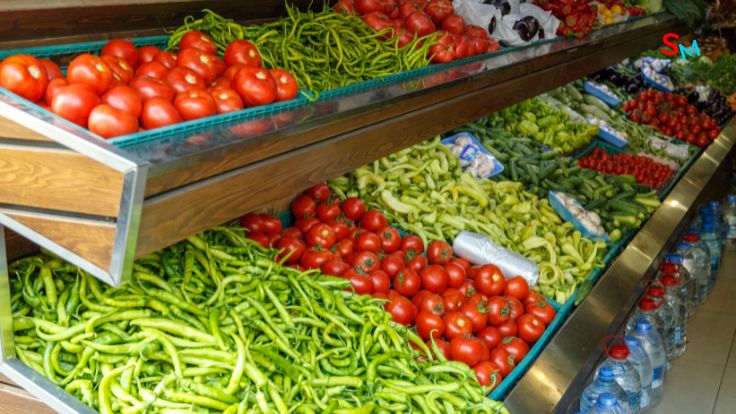How to eat healthy on a budget– Have you ever given up on a healthier diet for yourself and your family because organic and whole foods seem too expensive? I understand how you feel. You may think that nutritious foods are out of your reach.
Sometimes things happen in life and we are forced to tighten our budget. We might be so tempted to feel bad when we are racking our brains to figure out ways to save a tremendous amount on groceries by using coupons because your once generous grocery budget has been cut in half. See Things You Should Cut From Your Budget Immediately.
But, know this, It is usually when people are faced with health issues that they realize that the cheap, processed foods they were eating were not too good for them at all. Right there you will know that the goal was to have a real food diet that offers optimal nutrition for your family.
If you find yourself worrying about how to eat healthy on a budget, you’re not alone. The good news is that there are ways for you and your family to enjoy whole foods even when budget is tight.
Contents
- 1 1. Plan your meals
- 2 2. Cook at home
- 3 3. Buy in bulk
- 4 4. Embrace frozen fruits and vegetables
- 5 5. Shop seasonally
- 6 6. Explore farmer’s markets
- 7 7. Use cheaper protein sources
- 8 8. Opt for whole foods
- 9 9. Buy generic brands
- 10 10. Use coupons and discounts
- 11 11. Grow your own herbs and vegetables
- 12 12. Prepare meals in batches
- 13 13. Limit eating out
- 14 14. Make your own snacks
- 15 15. Plan for leftovers
- 16 16. Reduce meat consumption
- 17 17. Avoid sugary drinks
- 18 18. Compare prices
- 19 19. Utilize discount grocery stores
- 20 20. Prepare meals from scratch
- 21 Conclusion
1. Plan your meals

Planning your meals is my best way to eat healthily on a budget. It means deciding in advance what you will eat each day, which helps you avoid buying unnecessary things and wasting food. Let’s say you want to have a healthy lunch. You could plan to make a simple salad with lettuce, tomatoes, cucumbers, and some grilled chicken. Then, you can write down all the ingredients you need and check your kitchen to see what you already have. This way, when you go grocery shopping, you know exactly what to buy and won’t overspend. By planning your meals, you can eat nutritious food and save money too!
2. Cook at home
Let’s say you’re craving a cheesy pizza. Instead of buying one, you can buy some pizza dough, tomato sauce, cheese, and your favourite toppings from the grocery store. Then, you can have fun stretching the dough, spreading the sauce, and adding your toppings. Pop it in the oven, and voila! You have a homemade pizza that’s not only healthier but also cheaper than ordering one. Plus, cooking at home gives you control over the ingredients, so you can make it as nutritious as you want. So, instead of eating out or ordering takeout, you can make your own delicious meals.
3. Buy in bulk

Buying in bulk is a clever strategy to eat healthy while saving money. When you buy in bulk, you purchase larger quantities of food at once, which usually costs less per unit. Let’s say you love snacking on nuts. Instead of buying small packs, you can buy a big bag of mixed nuts. This way, you get more nuts for a lower price. You can store them in smaller containers at home, refilling as needed. Buying in bulk works well for items like rice, pasta, beans, and spices too. Just make sure to check the expiration dates and store the food properly to keep it fresh. With bulk buying, you can stock up on healthy foods and stretch your budget.
4. Embrace frozen fruits and vegetables
Frozen fruits and vegetables are just as nutritious as fresh ones and can be more affordable. You can find a variety of options like berries, peas, and broccoli in the frozen aisle. These frozen goodies are picked at their peak freshness and quickly frozen, which locks in their nutrients. They also last longer, so you can buy them in bulk without worrying about spoilage. Whether you add them to smoothies, soups, or stir-fries, frozen fruits and vegetables are a convenient and budget-friendly choice for a balanced diet. see how to grocery shop on a budget.
5. Shop seasonally

When you shop for produce during its peak season, it tends to be fresher and cheaper. In the summer, you can find juicy watermelons and sweet berries, while in the winter, citrus fruits like oranges are in abundance. By choosing seasonal foods, you can enjoy a variety of nutritious options without spending too much money. Plus, they often taste better too! So, keep an eye out for what’s in season and enjoy delicious and affordable meals all year round.
6. Explore farmer’s markets
Farmer’s markets are local markets where farmers sell their fresh produce directly to customers. Here’s how it works: Imagine waking up on a sunny Saturday morning and heading to your nearby farmer’s market. You can find rows of colourful fruits, vegetables, and even homemade jams and bread. Since the produce comes directly from the farmers, it’s often cheaper than what you find in regular stores. Plus, you can ask the farmers questions about how the food was grown. So, grab a basket and support local farmers while getting the freshest and most affordable ingredients for your healthy meals!
7. Use cheaper protein sources

Beans and lentils are packed with protein and are much cheaper than buying meat. So, instead of buying expensive meats, you can choose more affordable options that still provide the protein your body needs. You can make delicious dishes like chilli with kidney beans or lentil soup.
Another budget-friendly option is tofu, which is made from soybeans and can be cooked in various tasty ways. Eggs are also a great choice—they are versatile, nutritious, and inexpensive. By choosing these cheaper protein sources, you can save money while still getting the essential nutrients your body requires.
8. Opt for whole foods
Whole foods are natural and unprocessed, which means they don’t have added sugars, fats, or chemicals. For example, instead of buying a box of sugary cereal, you can choose whole grain oats and add your own toppings like fresh fruits and nuts. Instead of buying pre-cut and packaged vegetables, you can buy a whole head of lettuce and chop it yourself. By choosing whole foods, you not only save money but also ensure you’re getting all the nutrients your body needs. So, next time you’re at the grocery store, look for whole foods and get creative with your own delicious and budget-friendly meals.
9. Buy generic brands

Generic brands are products that don’t have a fancy name or flashy packaging but offer the same quality as popular brands. Instead of buying a popular brand of cereal, you can choose the store’s own brand. The cereal might have a different name and packaging, but it has the same nutritious ingredients at a lower price. The same goes for other items like pasta, canned goods, or snacks. So, next time you go shopping, compare prices and give generic brands a try. You’ll be surprised at how much money you can save while still enjoying healthy and delicious food.
10. Use coupons and discounts
Using coupons and discounts is in fact a very clever way to eat healthy on a budget. Coupons are like special tickets that give you discounts on certain products. So, next time when you’re craving a healthy breakfast with cereal and yoghurt. Before going to the grocery store, you can look for coupons online or in newspapers. If you find a coupon for the cereal or yoghurt you like, you can use it at the checkout and get a lower price. Some stores also have special discounts or loyalty programs that can save you money. So, keep an eye out for coupons and discounts to enjoy your favourite healthy foods without spending too much.
11. Grow your own herbs and vegetables

Imagine having a small garden or even just a few pots on your windowsill. You can plant herbs like basil, mint, or parsley, which add flavour to your meals without costing much. You can also grow vegetables like tomatoes, lettuce, or peppers. By growing your own, you save money on buying them from the store and have the satisfaction of eating something you nurtured. Plus, gardening is a fun and rewarding hobby. So, grab some seeds, soil, and water, and start growing your own fresh and nutritious ingredients!
12. Prepare meals in batches
Preparing meals in batches is also another good way to eat healthily on a budget. It means cooking a large amount of food at once and dividing it into individual portions to enjoy later. For example, on a Sunday afternoon, you can make a big pot of vegetable soup or a casserole with lots of veggies and lean protein like chicken or beans. Once it’s done, you can portion it out into containers and freeze them. Then, when you’re busy or don’t feel like cooking, you can simply heat up one of your pre-prepared meals. By cooking in batches, you save time, money, and ensure you always have a healthy meal ready to go.
13. Limit eating out

When we eat out at restaurants or order takeout, it can be expensive and sometimes less healthy. Let’s say you’re craving a burger. Instead of going to a restaurant, you can make your own burger at home using lean ground beef or a veggie patty. You can add fresh lettuce, tomato, and whole grain buns. By cooking at home, you not only save money but also have control over the ingredients and portion sizes. So, try to save eating out for special occasions and enjoy homemade, healthier versions of your favorite meals!
14. Make your own snacks
Making your own snacks is a very smart way to eat healthy on a budget. Instead of buying expensive packaged snacks, you can create your own delicious and nutritious treats at home. For instance, if you’re craving something sweet, you can make homemade granola bars using oats, nuts, and dried fruits. If you prefer savoury snacks, you can bake your own crispy kale chips by tossing kale leaves with a little olive oil and seasoning. Not only are these snacks healthier, but they’re also more affordable in the long run. So, put on your chef hat, get creative, and enjoy homemade snacks that are good for you and your wallet!
15. Plan for leftovers

Planning for leftovers is another clever way to eat healthy on a budget. It means intentionally cooking extra food to enjoy as meals later on. If you make a big pot of spaghetti for dinner, you can save the leftovers in a container for lunch the next day. By doing this, you not only save time but also money, as you’re utilizing the ingredients you already have.
Leftovers can be repurposed into new dishes too. For instance, leftover roasted chicken can be turned into a tasty chicken salad for sandwiches. So, when you’re cooking, plan for leftovers and give yourself a head start on your next delicious and budget-friendly meal!
16. Reduce meat consumption
Meat can be expensive, so choosing to have meatless meals or reducing the amount of meat you eat can save you money. If you usually have chicken for dinner, you can try a delicious and filling vegetarian dish like a bean burrito or vegetable stir-fry. Beans, lentils, tofu, and eggs are affordable sources of protein that can replace meat in many meals.
By incorporating more plant-based options, you not only save money but also enjoy a variety of nutritious and budget-friendly meals. So, give it a try and discover the tasty world of meatless cooking!
17. Avoid sugary drinks

Ladies and gentlemen, Instead of reaching for sugary sodas or fancy coffee drinks, opt for healthier and more cost-effective alternatives. You can choose water or unsweetened tea instead of soda. If you’re craving something fruity, make your own refreshing fruit-infused water by adding slices of lemon, berries, or mint leaves. Another option is to make your own homemade smoothies using fresh fruits, yoghurt, and ice. Not only are these choices better for your health, but they also save you money by avoiding the high cost of sugary drinks. So, skip the sugary beverages and quench your thirst with healthier and budget-friendly options!
18. Compare prices
Comparing prices simply means taking the time to look at different options and choose the ones that give you the best value for your money. For example, let’s say you want to buy apples. Instead of grabbing the first bag you see, compare prices between different brands or sizes. You might find that one store offers a better deal than another. The same goes for other groceries too. By comparing prices, you can save money on your overall grocery bill while still getting the nutritious foods you need. So, be a savvy shopper and make informed choices to stretch your budget further!
19. Utilize discount grocery stores

Utilizing discount grocery stores is also another clever way to eat healthy on a budget. patronise stores that offer lower prices on a wide variety of food items, allowing you to save money without compromising on quality. For instance, instead of shopping at a regular supermarket, you can visit a discount grocery store and find great deals on fresh produce, canned goods, and pantry staples. It’s like a treasure hunt for affordable, healthy foods! Just remember to check expiration dates and compare prices to ensure you’re getting the best value. By shopping at discount grocery stores, you can keep your wallet happy while filling your cart with nutritious options for your meals.
20. Prepare meals from scratch
Instead of buying pre-packaged or processed foods, you can create your own meals using fresh ingredients. For example, instead of buying frozen pizza, you can make your own using whole wheat dough, tomato sauce, and your favourite toppings. By cooking from scratch, you have control over the quality and quantity of ingredients, and it often works out to be more cost-effective. Plus, it can be a fun and creative activity! So, grab a recipe, put on your apron, and enjoy tasty and nutritious meals made with love and your own hands.
Conclusion
Don’t feel discouraged! Start by making small changes in your food choices. You’ll be surprised to discover that you were actually spending more money on processed foods than you realized.
Remember, this journey towards healthier eating is about progress, not perfection. Be patient with yourself and celebrate each small victory along the way. Before you know it, you’ll develop a taste for nutritious foods and feel the positive impact they have on your overall well-being even financial well-being as well. So, stay motivated and embrace this exciting change in your relationship with food and your budget.
Leave a Reply